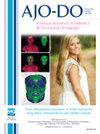不同下颌推进装置设计治疗阻塞性睡眠呼吸暂停的疗效和依从性:一项系统回顾和荟萃分析。
IF 3
2区 医学
Q1 DENTISTRY, ORAL SURGERY & MEDICINE
American Journal of Orthodontics and Dentofacial Orthopedics
Pub Date : 2025-06-01
DOI:10.1016/j.ajodo.2025.01.006
引用次数: 0
摘要
本系统综述和荟萃分析旨在评估不同下颌推进装置(MADs)治疗阻塞性睡眠呼吸暂停的疗效和依从性,重点关注可滴定与不可滴定以及定制与预制装置。方法:在国际系统评价注册(PROSPERO CRD42024557402)上进行全面的文献检索,检索截止到2024年6月的Ovid MEDLINE、Ovid Embase和Web of Science。包括比较MAD设计的随机对照试验和非随机研究。主要终点为呼吸暂停低通气指数(AHI)降低。次要结果包括Epworth嗜睡量表评分、依从率和患者偏好的改善。使用随机试验的偏倚风险工具评估偏倚风险,使用干预工具的非随机研究的偏倚风险评估。采用加权平均差(WMD)和95%置信区间(CI)进行meta分析。结果:共纳入22项研究,其中随机对照试验15项,非随机对照试验7项。meta分析显示,可滴定和不可滴定MADs均可显著降低AHI,组间无显著差异(WMD: 1.16;95% CI, -1.29 ~ 3.61;P = 0.35)。与现成的MADs相比,定制的MADs略微显著降低了AHI (WMD: 1.51;95% CI, -0.08 ~ 3.11;P = 0.06)。定制MADs也显示出更高的依从率和更长的佩戴时间(WMD: 1.19;95% ci, 0.65-1.73;结论:可滴定的和不可滴定的MADs,以及定制的和现成的MADs,都能有效治疗阻塞性睡眠呼吸暂停,没有明显的偏好。然而,定制的MADs通常副作用更少,并且具有潜在的依从性优势。建议进一步开展高质量的研究,并进行更长时间的随访。本文章由计算机程序翻译,如有差异,请以英文原文为准。
Efficacy and adherence of different mandibular advancement devices designs in treatment of obstructive sleep apnea: A systematic review and meta-analysis
Introduction
This systematic review and meta-analysis aimed to evaluate the efficacy and adherence of different mandibular advancement devices (MADs) designed to treat obstructive sleep apnea, focusing on titratable vs nontitratable and custom-made vs ready-made devices.
Methods
Registered with the International Register of Systematic Review (PROSPERO CRD42024557402), a comprehensive literature search was conducted across Ovid MEDLINE, Ovid Embase, and Web of Science up to June 2024. Randomized controlled trials and nonrandomized studies comparing MAD designs were included. The primary outcome was apnea-hypopnea index (AHI) reduction. Secondary outcomes included improvements in Epworth Sleepiness Scale scores, adherence rates, and patient preference. The risk of bias was assessed using the risk-of-bias tool for randomized trials, and the Risk-Of-Bias In Nonrandomized Studies of Intervention tools. Meta-analyses were performed with weighted mean differences (WMD) and 95% confidence intervals (CI).
Results
A total of 22 studies were included, comprising 15 randomized controlled trials and 7 nonrandomized studies. Meta-analysis showed significant AHI reduction with both titratable and nontitratable MADs, with no significant difference between groups (WMD: 1.16; 95% CI, −1.29 to 3.61; P = 0.35). Custom-made MADs demonstrated a marginally significantly greater reduction in AHI compared with ready-made MADs (WMD: 1.51; 95% CI, −0.08 to 3.11; P = 0.06). Custom-made MADs also showed higher adherence rates and longer wearing times (WMD: 1.19; 95% CI, 0.65-1.73; P <0.0001) and higher adherence rates.
Conclusions
Both titratable and nontitratable MADs, as well as custom-made and ready-made MADs, effectively treated obstructive sleep apnea, with no clear preference for one design over another. Custom-made MADs, however, generally had fewer side effects and offered potential adherence advantages. Further high-quality studies with longer follow-ups are recommended.
求助全文
通过发布文献求助,成功后即可免费获取论文全文。
去求助
来源期刊
CiteScore
4.80
自引率
13.30%
发文量
432
审稿时长
66 days
期刊介绍:
Published for more than 100 years, the American Journal of Orthodontics and Dentofacial Orthopedics remains the leading orthodontic resource. It is the official publication of the American Association of Orthodontists, its constituent societies, the American Board of Orthodontics, and the College of Diplomates of the American Board of Orthodontics. Each month its readers have access to original peer-reviewed articles that examine all phases of orthodontic treatment. Illustrated throughout, the publication includes tables, color photographs, and statistical data. Coverage includes successful diagnostic procedures, imaging techniques, bracket and archwire materials, extraction and impaction concerns, orthognathic surgery, TMJ disorders, removable appliances, and adult therapy.

 求助内容:
求助内容: 应助结果提醒方式:
应助结果提醒方式:


